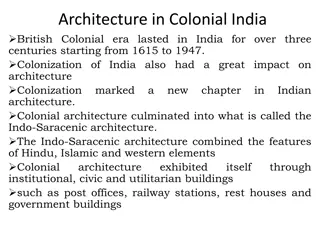Architecture in Colonial India: A Blend of Cultures
British Colonial architecture in India during the 17th to 20th centuries combined Hindu, Islamic, and Western elements, leading to the unique Indo-Saracenic style. This architectural era saw the construction of institutional and civic buildings showcasing a mix of Gothic, Neo-Classical, Indo-Islamic, and Indian architectural influences. Notable structures like St. Paul's Cathedral in Kolkata represent the fusion of different design elements, creating a distinctive architectural identity in colonial India.
Download Presentation

Please find below an Image/Link to download the presentation.
The content on the website is provided AS IS for your information and personal use only. It may not be sold, licensed, or shared on other websites without obtaining consent from the author.If you encounter any issues during the download, it is possible that the publisher has removed the file from their server.
You are allowed to download the files provided on this website for personal or commercial use, subject to the condition that they are used lawfully. All files are the property of their respective owners.
The content on the website is provided AS IS for your information and personal use only. It may not be sold, licensed, or shared on other websites without obtaining consent from the author.
E N D
Presentation Transcript
Subject: History of Architecture -IV Topic: Architecture in Colonial India Presented by: Hiba Gul
Architecture in Colonial India British Colonial era lasted in India for over three centuries starting from 1615 to 1947. Colonization of India also had a great impact on architecture Colonization marked a architecture. Colonial architecture culminated into what is called the Indo-Saracenic architecture. The Indo-Saracenic architecture combined the features of Hindu, Islamic and western elements Colonial architecture exhibited institutional, civic and utilitarian buildings such as post offices, railway stations, rest houses and government buildings new chapter in Indian itself through
Anglo-Indian church builders to follow the model set by Gothic art in Italy/England Indo Saracenic Architecture: Indo-Saracen is Revival architecture also referred as Indo-Gothic, Neo-Mughal, Mughal-Gothic and Hindu-Gothic. It was a combination of the Gothic revival style with that of the Neo-Classical, Indo-Islamic and Indian architectural style that was initiated by the British architects.
St Paul's Cathedral, Kolkata St Paul's Cathedral, Kolkata, India. Architect: William Nairn Forbes (1796-1855) The first stone was laid in 1839, and the building was completed in 1847. This makes St Paul's the first Anglican cathedral of the Victorian age The building was constructed in a peculiar brick the dressings were of Chunar stone The whole edifice was covered inside and out with polished chunam The latter is a kind of stucco, and it gives the cathedral almost an ethereal aspect.
St Paul's as the very first Anglican cathedral outside Britain, was inspired by James Gibbs's St Martin's-in- the-Fields by Trafalgar Square in London. The cathedral was to lose its steeple later on, as a result of earthquakes, but the redesigned early twentieth-century tower is still "on the pattern of the Bell Harry Tower of Canterbury Cathedral"
Interior "The roof is unusual. It is a shallow curve spanned by iron trusses adorned with Gothic tracery," explains Davies: "when built, it was one of the largest spans in existence"
Town Hall Town Hall is one of the most majestic structures among the other heritage buildings in the city of Mumbai. The Town hall was colloquially called as 'Tondal' during the 19th century. The Town Hall houses the 'Asiatic society of Bombay' (Mumbai) Mumbai's Town Hall is a colonial structure and was built in 1833.
Architecture The Town Hall was designed by Colonel Thomas Cowper who was one of the best engineers in Bombay (Mumbai). With a span of 200 feet and height of 100 feet, the structure was inspired by Greek and Roman styles of architecture. The entrance of the building is adorned with a Grecian portico and 8 impressive Doric styled pillars. There is a flight of 30 steps leading to the entrance of the Town Hall. The entire construction was made of stones brought from England and was beautifully designed in a neo-classical fashion. Within the building, the floors are covered in ancient wood, the staircases are spiral and the terraces are adorned with beautiful wrought iron. The hall boasts of a collection of remarkable marble statues of Indian patrons of the 19th century.























